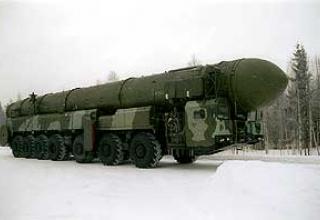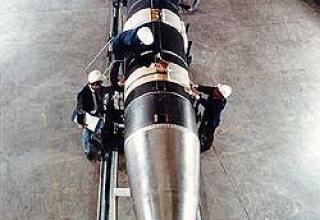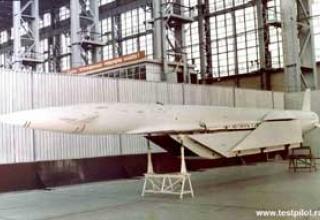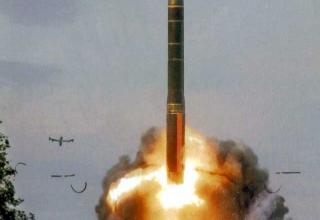"Temp-2S" is a mobile ground-based strategic missile system, with third-generation ICBMs, designed to strike targets heavily protected by air defense and located in the depths of enemy territory. It was created under the supervision of Chief Designer Alexander Nadiradze. The first missile was launched on March 14, 1972. Its testing was conducted at the Plesetsk test site for more than two and a half years, until December 1974. During the tests 35 launches were made, the results of which the missile was adopted for service.
The mobile launcher was created in Volgograd Central Design Bureau "Titan". Mass production of the missile was launched at the Votkinsk Engineering Plant.
The first two missile regiments went on combat duty on February 21, 1976 (Plesetsk, commanders LF Firsov, VV Runov), a total of seven missile regiments (six PU). According to data published in the U.S., from 1978 to 1985, was deployed from 50 to 100 ICBM "Tempo-2S" near Plesetsk.
Under the Treaty of OSV-2, signed in June 1979 by the leaders of the USSR and the United States, the Soviet Union undertook not to produce, test or deploy the Temp-2S missile system. As a result, the missile system (RK) was removed from combat duty in 1986 and eliminated.
In the west, the complex was designated SS-16 "Sinner".
Continuation of RK "Temp-2S" were BRSD-10 "Pioneer" and "Topol".
Composition:
A number of fundamental novelties have been applied to the missile design. Grids, aerodynamic rudders opened in flight, central control nozzles, fiberglass control nozzles, fiberglass high-strength housing of propulsion systems. A cold stage separation scheme has been developed, in which subsequent stages were launched only after the previous stages had departed to a safe distance. The combat stage is equipped with a solid fuel propulsion system for the first time. The rocket itself was in a sealed TPK made of fiberglass with a thick layer of insulating foam during the entire period of operation. Mortar launch was carried out directly from the container with the help of special PAD. The marching engines were already switched on at an altitude, thanks to which the PU remained operational.
The control system was built on the basis of a high reliability, accuracy and speed digital forging machine and had two autonomous units: an on-board and ground control system.
The ground control system solved the problems of control of LCS automatics, preparation of initial data and calculation of the flight task.
The on-board control system had a gyrostabilized platform with high-precision accelerometers oriented in three directions with optical communication with the ground sighting system, as well as the BCVM.
Due to insufficient reliability of the BCVM element base in the DS, the channels were "triplicated", which naturally led to the weighting of the on-board equipment. In order to reduce the weight, the devices were made in a non-hermetic version and were placed in a sealed instrument compartment. To simplify the calculation of the flight task with the functional guidance method for the entire range, a single system of flexible pitch angle programs was used. The starting range was adjusted by cutting off the thrust by means of a transverse cut of the third stage engine housing.
Two solid fuel charges were used in each of the marching propulsion systems (developed by Luberets NPO "Soyuz", Chief Designer Zhukov B.P.): a large one was attached to the cylindrical part of the hull, a small one to the front bottom so that the hull was protected from unburned fuel heating most of the time. For the tilting controls on the upper stages, a special non-metallic solid fuel was created, which included hexogen, as condensed oxides of the aluminum, which is the main fuel, could clog the air valves. The first stage was controlled by expanding lattice aerodynamic rudders and refractory tungsten gas rudders used in the initial flight section.
The Temp-2C rocket complex consisted of two vehicles based on MAZ-547A chassis: a launcher and a transport and charging machine. Both of them had special equipment, the composition of which resulted from the purpose of the machines. Thus, the launcher had in its aft part devices designed to bring the transport and launch container from the camping position to the combat and back. In addition, the vehicle was equipped with special hydraulic jacks that were used to unload the chassis, horizon and ensure the stability of the launcher during the launch of the missile.
A high-powered power unit was mounted in the front of the machine. On both sides of it were installed two non-metal cabins. The machine had twelve single wheels, equipped with wide tires. Ten of the twelve wheels were the leading ones. The wheels of the first three axles were made controllable.
Characteristics:
| Range of fire, km | 10500 |
| Firing accuracy, km | 0,45-1,64 |
| IBR 15G42 | |
| Control system | |
| -type | Inertial with BCVM |
| -designer | NIIAP |
| -chief constructor | Pilyugin N.A. |
| Steering actuators: | |
| -type | Hydraulic |
| -designer | CNIIAG |
| Control and stabilization bodies: | |
| -I stage | Refractory tungsten gas and aerodynamic grating rudders, grating stabilizers. |
| -II stage | On the heel - gas nozzles with a gas generator; on the pitch and yaw - blowing in the critical part of the hot gas nozzle. |
| -III stage | On the heel - gas nozzles with a gas generator; on the pitch and yaw - blowing in the critical part of the hot gas nozzle. |
| Type of start | "mortar" from the TIC with a PAD. |
| Number of rocket stages | 3 |
| The length of the rocket: | |
| - complete, m | 18,5 |
| -without the head end, m | 16,9 |
| Maximum housing diameter, m | 1,79 |
| Start weight, t | 43 |
| Fuel type | Hard-mixed. |
| Stage one: | |
| Dimensions: | |
| -length, m | 8,58 |
| -diameter, m | 1,79 |
| -the weight of the harnessed step, t | 26,63 |
| The engine: | |
| -Type | single-chamber RDTT |
| -nozzle number | 1 |
| Stage two: | |
| Dimensions: | |
| -length, m | 4,4 |
| -diameter, m | 1,47 |
| -the weight of the harnessed step, t | 8,7 |
| The engine: | |
| -Type | single-chamber RDTT |
| -nozzle number | 1 |
| Stage three: | |
| Dimensions: | |
| -length, m | 3,9 |
| -diameter, m | 1,3 |
| -the weight of the harnessed step, t | 8,7 |
| The engine: | |
| -Type | single-chamber RDTT |
| -nozzle number | 1 |
| Fighting unit: | |
| -Type | Monoblock thermonuclear |
| -Charge power, Mt. | 0,65-1,5 |
| -weight, kg | 1000 |
| -length, m | 1,6 |
| -separation system | four RDTs of low thrust |
| launcher | |
| wheel arrangement | 12x10 |
| maximum speed, km/h | 40 |
| turning radius, m | 21 |
| overturnable climb, deg. | 15 |
| overpassable ford, m | 1 |
| engine | Diesel, liquid coolant, 746 hp. |
Testing:
Strela-1 and Strela-1M complexes were widely exported by the USSR abroad. They were supplied to the countries-participants of the Warsaw Pact, to Yugoslavia, to the states of Asia (Iraq, Syria, North Yemen, India, Vietnam), Africa (Algeria, Angola, Benin, Egypt, Guinea, Guinea-Bissau, Libya, Madagascar, Mali, Mauritania, Mozambique) and Latin America (Cuba, Nicaragua), confirming their rather high efficiency and ease of use during military conflicts and during training firing.
The first use of the Arrow 1 SAM system was in the Bekaa Valley in southern Lebanon in 1981. In December 1983, these SAMs were shot down by American A-6E and A-7E aircraft (the latter, probably, was hit by portable SAMs of Strela-2 family). In the same year, several Arrow 1 SAM systems were captured by South African invaders in southern Angola.
Sources:
- 1. Колесников С. Г. "Стратегическое ракетно-ядерное оружие". Арсенал-Пресс 1996 год.
- 2. Белоцеровский С. М. "Решетчатые крылья" 1985 год
- 3. Первов М. А. "Ракетные комплексы ракетных войск стратегического назначения" 'Тип новости' 1999 год.
- 4. Карпенко А.В. "Отечественные стратегические ракетные комплексы" 1996 год.
- Военные автомобили СССР






